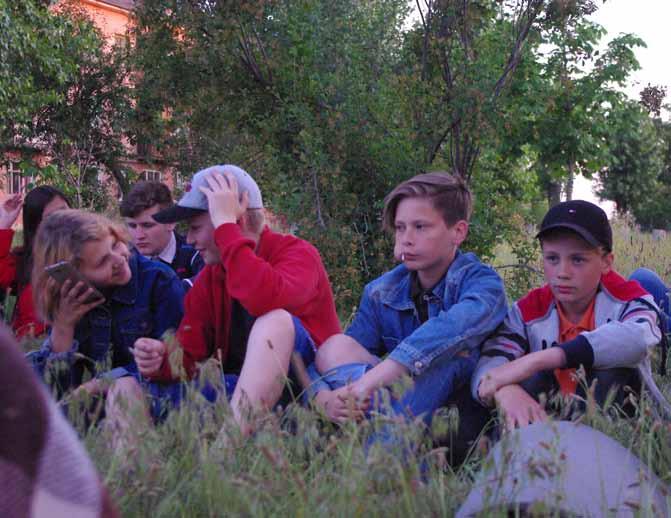
15 minute read
Stanytsia Luhanska
There are several very active people in the town who regularly participate in civil society forums, training, and support programs. They also raise questions on corruption and how to improve the use of the local budget for infrastructure and culture. There are also a small number of volunteer youth groups and a children’s club for young journalists
In addition, the state organization “Agency of social development of Shchastya” works in the town, as do the Center for Psycho-Social Adaptation of Shchastya Municipality and the state-run Psychological Crisis Service. The latter also conducts events for adults and children.
Advertisement
People in Shchastya seem to identify strongly with their region. They mention the particular culture of Donbas and how it is different from the rest of Ukraine. This seems to contribute to a readiness to engage in civil society activities. Our project participants longed for pre-war life and access to the city of Luhansk, as well as for the currently NGC area. However they did not sympathize with the self-proclaimed “LNR”.
Current problems and needs
Participants in our training reported a high level of aggression in daily life. They observed a growth of disputes between neighbors, within families, and at the workplace, which they trace back to the psycho
social consequences of war. They asked for support in conflict resolution and in maintaining a more peaceful and united local society.
The main declared needs lie in the field of self-education, obtaining theoretical and practical information on the topic of stress management, time management, mindfulness, non-violent communication, methods of peaceful conflict resolution. There is a need for continuous group training and individual psychological consultations, as well as mentoring (supervision). There is also a request from teenage high school students for training related to non-violent communication, as well as inter-gender and inter-generational communication.
The proximity to the demarcation line, together with a history of active warfare and frequent shelling has been causing stress, fear of hostilities and a constant feeling of insecurity and lack of prospects. Residents of Shchastya report symptoms of chronic stress and psychological trauma associated with the military conflict and the social situation that has emerged from the conflict. Respondents articulated the need for trauma-informed counseling, therapeutic individual and group care and, particularly, bodyoriented trauma release techniques.

Severodonetsk
Previously only known for its chemical enterprises, the youngest city of Luhansk region became its
administrative capital in September 2014. The former administrative capital, the city of Luhansk, is
still controlled by the illegal military formations of the self-proclaimed “Lugansk People´s Republic”
(“LPR”). 44 Since 2014, the city has managed to deal with the relocation of institutions as well as with the
accommodation and integration of a large number of Internally Displaced Persons (IDPs), partly thanks to substantial support from international humanitarian and development organizations.
From sandy steppes to a chemical industry hub
Severodonetsk is located in the steppe of eastern Ukraine, in a valley of the Siverskyi Donets River 45 .
The history of Severodonetsk is closely linked to the construction of the Lysychansk Nitrogen Fertilizer
Plant, today known as the chemical plant “Azot” (Russian for nitrogen). 46 Despite plans to accommodate
the construction workers in nearby Lysychansk – the oldest mining city in Luhansk region –, the first huts
and brick buildings were completed in Liskhimstroy in 1934. 47 The construction of the plant and the
town was halted during the German occupation of 1941-1943. 48 In 1951, the plant began to operate. 49
A year earlier, Liskhimstroy´s inhabitants had voted to rename the settlement to Severodonetsk, after
the nearby river Siverskyi Donets. In 1958 it received the status of a city. The year 1934, when the
construction workers settled in Liskhimstroy, is considered the foundation year of Severodonetsk. 50
Throughout the 1960s and 1970s, the city grew rapidly. People from all over the Soviet Union flocked
to the “city of the chemists”, which offered job opportunities and housing space. By the mid-1970s, the
population exceeded 100,000. 51 At its peak, the chemical plant was one of the largest producers of
chemical fertilizers in the Soviet Union. In the tough 1990s, the production was scaled down, also due
to the lack of technology modernization. In 2011, the Ukrainian oligarch Dmitryi Firtash integrated the
plant into his OSTCHEM holding, which is part of the DF Group. Currently the PrJSC “Severodonetsk
Azot Association”, as it is now called, constitutes the largest chemical enterprise in Ukraine, the second
largest in Europe, and a leading force in the production of acetic acid, methanol and vinyl acetate. 52
When the unrest began in 2014, the plant employed about 8000 people. 53
44 45 46 47 48 49 50 51 52 53 https://helsinki.org.ua/wp-content/uploads/2018/01/Executive-summary_Report-SeveroD_en-1.pdf https://ukrainetrek.com/severodonetsk-city http://svsever.lg.ua/2015/11/zhivaya_hronologiya_severodonecka https://ukrainetrek.com/severodonetsk-city http://svsever.lg.ua/2015/11/zhivaya_hronologiya_severodonecka http://www.ostchem.com/en/o-kompanii/proizvodstvo/sever http://svsever.lg.ua/2015/11/zhivaya_hronologiya_severodonecka https://ukrainetrek.com/severodonetsk-city http://www.ostchem.com/en/o-kompanii/proizvodstvo/sever https://www.opendemocracy.net/en/odr/a-frontline-factory/
On November 28, after the beginning of the Orange Revolution, Viktor Yanukovych, together with other
leaders of the pro-Russian Party of Regions and their allies held an “All-Ukrainian congress of deputies
of all levels” in Severodonetsk. At this congress, they called on the south-eastern regions (Donetska,
Luhanska, Zaporizhska, Kharkivska, Odesska, Khersonska, Mykolaivska, Dnipropetrivska, Crimea and the
City of Sevastopol) to hold a referendum and vote for the creation of a south-eastern autonomous state,
in the form of a federative republic with the capital in Kharkiv, in the event that Viktor Yushenko should
become president. Already then, some local leaders discussed the possibility of asking the Russian
Federation for support if their demands were not met. 54 Ever since then, Severodonetsk has been known
in Ukraine as a stronghold of separatist aspirations. 55
From 22 May to 22 June 2014, Severodonetsk was controlled by illegal armed forces, namely a group of
militants named “Prizrak” (“the Ghost”) headed by the warlord Oleksii Mozghovyi. 56 Unlike other cities,
Severodonetsk did not suffer any serious damage to buildings or infrastructure. Seemingly the risk of hitting the nearby chemical plant Azot and causing serious environmental damage to the whole region was estimated as too high.
On 19 July 2014, the Ukrainian military began a joint operation to liberate the strategically important
Lysychansk–Severodonetsk agglomeration. The National Guard, the Ukrainian Army and volunteer
battalions attacked the militants from two sides, resulting in a swift liberation of the city on 22 July.
During the time of occupation and liberation, 13 civilians lost their lives. 57 The leader of the operation
Colonel Oleksandr Radiyevskyi was killed in battle 23 July in Lysychansk. 58 His death is commemorated
by a memorial bust of him close to Severodonetsk city hall.
Conditions for Civil Society
To this day Severodonetsk is one of the largest industrial cities of Donbas, producing approximately
22% of Luhansk region’s total industrial output in 2014. 59 Its chemical, machine building and instrument
engineering enterprises are still operational, offering employment to thousands of people. Among the
largest plants are Azot, the fiberglass factory “Severodonetsky Stekloplastic” and SPRA “Impulse”, which
develops instrumentation and control systems for nuclear and heat power engineering facilities. 60
As mentioned before, Severodonetsk is now the administrative center of Luhansk Oblast. In March 2015, the Luhansk civil-military administration was established in Severodonetsk. The transfer of state and
http://novosti.dn.ua/en/news/253490-25-years-of-donbas-separatism https://www.radiosvoboda.org/a/28144452.html https://helsinki.org.ua/wp-content/uploads/2018/01/Executive-summary_Report-SeveroD_en-1.pdf http://khpg.org/index.php?id=1475581147 https://donbass.comments.ua/society/149-v-genshtabe-rasskazali-kak-prohodilo-osvobozhdenie-severodonecka-i-popasnoy.html https://www.obozrevatel.com/politics/28347-silyi-ato-nachali-zachistku-severodonetska-i-boi-za-lisichansk.htm https://www.obozrevatel.com/politics/28347-silyi-ato-nachali-zachistku-severodonetska-i-boi-za-lisichansk.htm
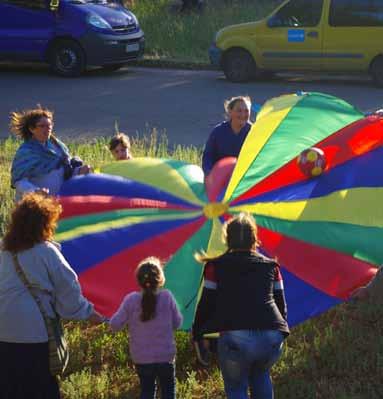
educational institutions from Luhansk to Severodonetsk and the demographic growth brought an economic boost to the city, creating new possibilities for small businesses in the food and service sectors. Nevertheless, the overall economic situation is characterised by stagnation – as in the rest of Donbas. Many young people move to other regions of Ukraine, or to other countries to find jobs.
The chemical industry has polluted the area known as the “Donbas chemical triangle” to the extent that the surroundings of Severodonetsk are unsuitable for agriculture and farming. 61
Since 2014, the international community is also widely represented in the city. Organizations such as the OSCE, UN, ICRC, Norwegian Refugee Council, Danish Demining Group, and others have their regional and field offices here, providing various services and support for conflict-affected people.
Local Civil Society
Compared to other cities in Luhansk region, Severodonetsk has an active and lively civil society represented by activists, community-based initiatives, local NGOs and associations native to the city or relocated from Luhansk. Many organisations evolved from initiatives to respond to the challenges of the 2014 emergency situation, providing legal and humanitarian aid, as well as various support functions around the relocation of people and institutions. In the meantime they have shifted to longterm development work providing psycho-social support, educational training, language courses, and organizing cultural events (see picture above).
The population of Severodonetsk is characterized by an increased interest in and motivation to attend educational and social events. People are particularly interested in methods of communication, selfgovernment and organization, pedagogy, and personal development. There is a huge interest in techniques as non-violent Communication, burn-out prevention, stress management, and work with trauma. Vostok-SOS regularly receives requests from residents of Severodonetsk to conduct psychoeducational activities and training sessions. As many people who attend training, talks and other events in Severodonetsk often work in other parts of the Oblast, civil society support in Severodonetsk has a great multiplication effect on other regions in the conflict zone.
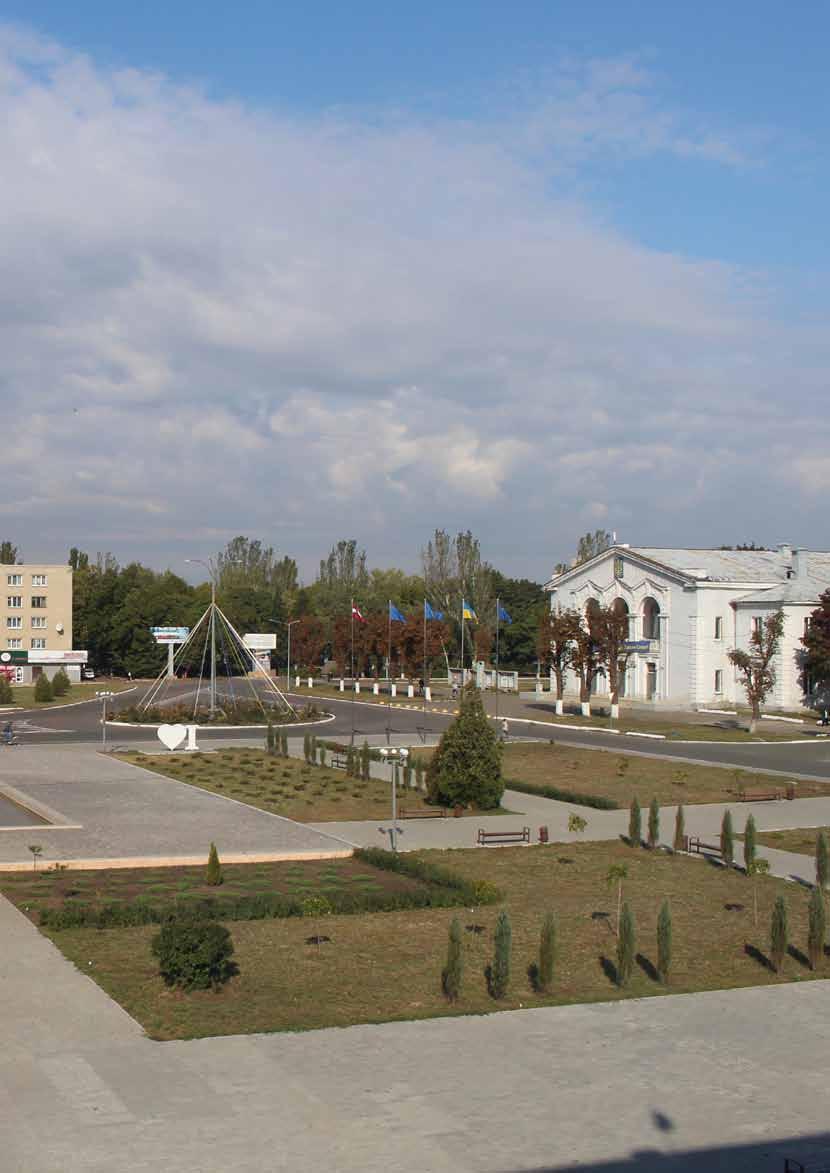
Popasna
Popasna is the largest town in the district of the same name, and the western-most town bordering the
self-proclaimed “Lugansk People´s Republic” (“LPR”), at just four kilometers from the demarcation line.
Before the war, it had been an important railway junction between Alchevsk, Pervomaisk and Luhansk
– all of which are now under the control of the self-proclaimed “LPR”. 62 Thus Popasna became an end
station with trains going only in the northern direction to Lysychanks and Svatove.
Like many cities in the east of the country, throughout the 1990s Popasna witnessed the decline of its
industrial enterprises, such as the Popasna Carriage Repair Factory, the glass factory, the bread factory and
the sewing factory. The town´s economy had mostly relied on the coal, railway and carriage maintenance
industries. Popasna´s locomotive and wagon depot used to be the largest in the Luhansk region. Most
of the factories and mines ceased to operate in 2010/2011, leaving thousands of people unemployed.
The bread factory, Popasna Carriage Repair factory and locomotive business are still operating, however
not on the same scale. Residents have taken up agriculture, both for self-catering and selling, in order to
survive. The economic hardship and the discontent of the residents made them susceptible to the idea of the “Russian Spring” like in the many other Donbas settlements. 63
Occupation, liberation, human rights violations
The first separatist rallies started in Popasna on April 1, 2014. The Anti-Terrorist Operation was officially
launched on April 14. Following the “referendum”, the city of Popasna was taken by the separatists. At
the beginning of July of the same year, a group of up to 200 Don Cossacks 64 entered the city and seized
control of the building of the prosecutor’s office. On July 11, separatists abducted the town´s mayor
Yurii Onyschenko and kept him in Pereval’sk. 65 At that time, Onyschenko had been planning to evacuate
women and children from the town. He was liberated a few days later by the Donbas battalion that also
liberated Popasna (National Guard) on July 22, 2014. 66
As a strategically important town, the separatist armed groups tried to seize control of it several times
after this liberation. They were mainly interested in controlling the railway and moving into Svitlodarsk. 67
The most active hostilities occurred from November 2014 through February 2015. 68
By February 2015 the population of Popasna had declined from 22,000 before the war to approximately 4000. Many had left the city due to heavy and systematic shelling. During the most active phase of
62 63 64 65 66 67 68 http://khpg.org/ru/index.php?id=1475581147#1475581147_30 https://helsinki.org.ua/wp-content/uploads/2018/07/Itog_Zvit_Popasna_A4_Eng_New.pdf p.4 Since 2014, Don Cossacks support the so-called LNR and DNR as independent volunteers, building several armed formations. http://khpg.org/ru/index.php?id=1475581147#1475581147_30 https://lb.ua/news/2014/07/15/272999_mer_popasnoy_osvobozhden_plena.html https://helsinki.org.ua/wp-content/uploads/2018/07/Itog_Zvit_Popasna_A4_Eng_New.pdf p. 7 http://khpg.org/ru/index.php?id=1475581147#1475581147_30
buildings and private houses. A total of 48 local civilians were killed as a result of the armed conflict
between 2014 and 2018. 69
Renovation and development: fair conditions for civil society
Since spring/ summer 2015, the situation in Popasna has stabilized. However, while still affected by shelling in some parts, the town is no longer being directly targeted. During this time, the city has gradually been rebuilt and redeveloped. Yurii Onyschenko is one of the only high-ranking officials who has remained in the town since the beginning of the war, performing his duties as usual. Due to his extraordinary engagement, it was possible to rebuild and repair the infrastructure, the supply system and residential buildings in Popasna.
The social sector and infrastructure have been restored thanks to joint efforts from the local, regional and
national budgets, the Carriage Repair factory, and a large part from international humanitarian organizations
such as International Committee of the Red Cross Society, Caritas, Norwegian Refugee Council, People in
Need and Medicines Sans Frontiers. Both the center of Popasna and outer parts of the city have been rebuilt,
squares and central streets are lit at night, a new church has been built, and new supermarkets and cafes have popped up. 70
Today, six schools and three kindergartens, a district hospital, a psycho-neurologic dispensary, the district court and prosecutor’s office, and other social and administrative services are operative.
https://helsinki.org.ua/wp-content/uploads/2018/07/Itog_Zvit_Popasna_A4_Eng_New.pdf p. 10-11 https://svoi.city/read/guide/58476/gajd-po-popasnoj#rec118443436
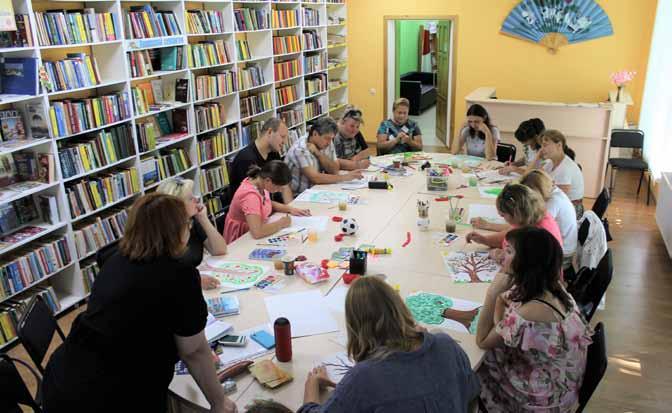
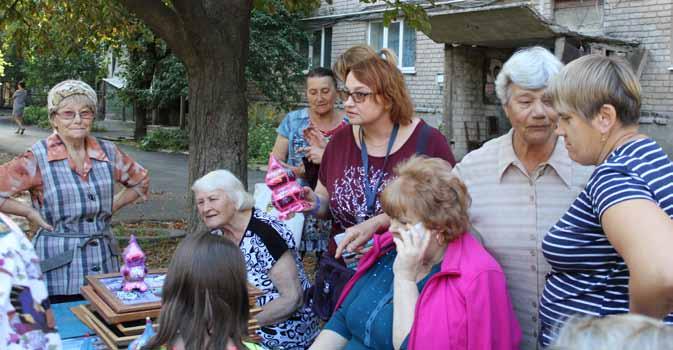
Civil society
Thus civil society in Popasna has much better conditions than, for instance, in Zolote. And this has a visible impact. The atmosphere seems more open to new things, more relaxed and more friendly. Inhabitants mention the huge effort that has been made to restore and renovate the town with satisfaction and pride. Maybe it is also due to this experience that they seem to be more ready for collective enterprises.
There is a new, spacious library, rebuilt with the support of the Japanese embassy. It works as a hub for the local civil society and NGOs. The library is a pleasant place for workshops and has several rooms for groups. (see left picture) It is also possible to hold workshops in the local music school. We experienced people in institutions as helpful and ready to support us, even at the last minute.
In the region, Popasna is known for its cultural life and artistic image. It houses many parks, wooden sculptures by the local artist Oleksandr Zavorotnyi, and murals from the French painter Gulien Mallan. The local lore museum shows the history of the region and the town. also hosts a number of festivals. Some are locally organized – the gastronomic festivals of borsch and vareniki –, others are organized from other parts of Ukraine such as “From the Country to Ukraine” (Z Krayiny v Ukrainu).
In Popasna there seem to be numerous people who are educated, well-informed and ready to participate in civil society action. In our training groups, people were hungry for new knowledge and new methods, were quick to acquire new methods, and almost instantly thought about how to apply these methods in their work and daily life. Particularly people who work in education, care and other social work seem to be keen to acquire skills that enable them to support the community, and particularly young people. They showed specific interest in the topics of stress and burnout-prevention, dealing with trauma, personal development, communication and dialogue.
To foster civil society in Popasna, it is important to support the people involved in their efforts. Workshops, training courses, conferences, whatever brings input and fresh knowledge to town, will be appreciated. Particularly helpful are practical methods that include movement and the body, and creativity, as there has been so far little experience with such methods and didactic practices.
Our participants and other inhabitants stressed that there is a vital need for trauma therapy, and methods for self-help and collective dealing with trauma. Now, as there is less shelling, people show symptoms of stress and social incapacity that are very likely connected to trauma. Participants underline that it is of utmost importance to address trauma to release people from stress, pain and social isolation and to support development towards a functioning civil society.
Moreover, parents and teachers report that there are problems at schools. Due to global trends like digitalization, but also due to the war, the relationship between teachers and students is changing. It is therefore necessary to support both groups, participants claim.
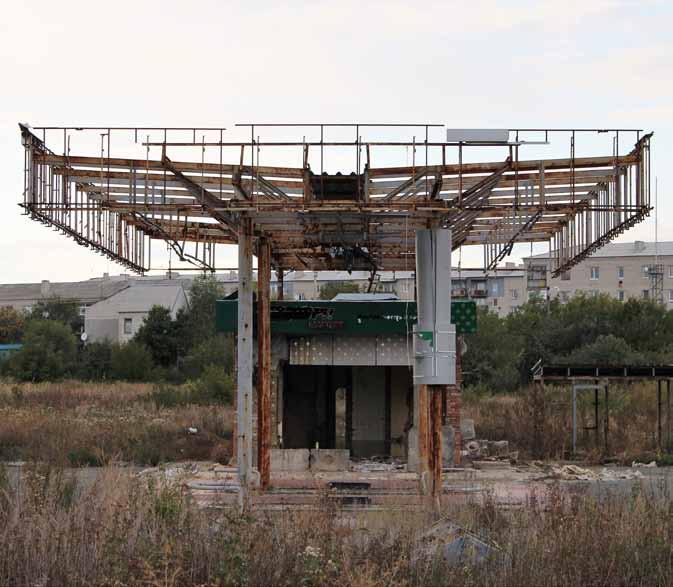
Another problem that needs to be addressed is the high level of burn-outs in the group of social workers and pedagogues, volunteers and civil society activists, essentially all groups that work directly with people. Participants of our program report that such people are often too absorbed by their job, do not distinguish between job and civil society activity, and have problems to draw a border and say “no” for the sake of self-care. Reportedly, many suffer from the feeling that their efforts do not have any results, that they do not receive and gratitude, and that other people do not value their efforts. With workshops or other inspiring educational means, this situation could be addressed.
Finally, there is a need for support in the eastern outskirts of Popasna which are very close to the frontline (see picture below). In these neighborhoods, people are suffering from frequent shelling up to the present day. Many houses are damaged, a considerable number of them are abandoned. Infrastructure is very weak, forming a sharp contrast to the town center, where most conflict- related problems have been solved. People from Eastern Popasna report the massive impact of the shelling on their daily life, including stress symptoms and anxiety. They express that they feel forgotten and abandoned now, as the conflict hardly appears in international media any more, and many people do not expect that, even in the current climate of peace talks and prisoners´ exchanges, the shelling has actually never stopped.




